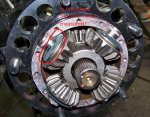88atlas07
New member
- 14
- 4
- 3
- Location
- Springtown, Texas
I'm the guy on the LMTV FB asking all the measurement questions. I'm about two weeks out from doing the 3.07 gears (still waiting on seals etc) and after a lot of research plan on doing the TM method of measurement, although I have ordered a spare hub that I'll cut down and try the open hub method everyone is talking about. The Army style of measurement is simple to understand as per Neil's Video and seems fail safe if you take your time. The open hub method still leaves me with questions....how exactly do I go about measuring gear lash with it all clamped up? There are pics floating around with feeler gauges being used but doesn't specify on what.
I'm starting to feel retarded because I don't understand the clamped method at all. Maybe once I take it all apart it'll make better sense. So far definitely going the TM preferred method as Neil demonstrated in his video, but will confirm the clamped method while I have it all apart if we can figure out what to measure.
I'm starting to feel retarded because I don't understand the clamped method at all. Maybe once I take it all apart it'll make better sense. So far definitely going the TM preferred method as Neil demonstrated in his video, but will confirm the clamped method while I have it all apart if we can figure out what to measure.
Attachments
-
148.2 KB Views: 20



